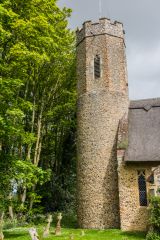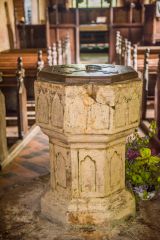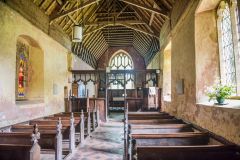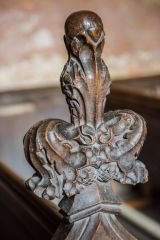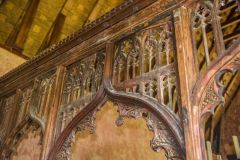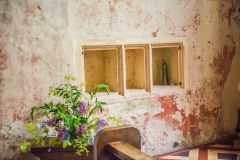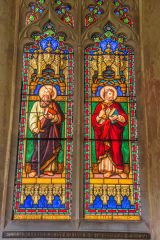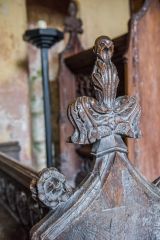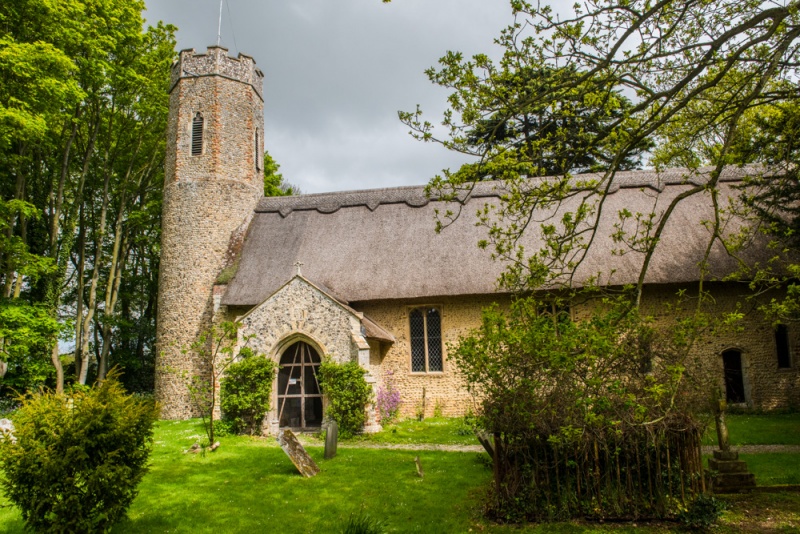
Most people come to the Norfolk village of Horsey to see the picturesque windmill (actually not a mill at all but a windpump built to help drain the surrounding fens). The wind pump stands well south of the village centre, but tucked away in the village itself, hidden by a screen of trees from the B1159 coastal road, is a historic treasure that remains unknown to most tourists in this petty area of the Norfolk coast.
The ancient thatched church of All Saints is one of the prettiest country churches in a county that seems to specialise in pretty country churches. It stands within a shaded churchyard, bounded on one side by the Old Rectory and on the other by Horsey Hall.
The church was probably begun in the 10th century, long before the coming of the Normans. The church is built on a very simple Saxon layout, with a round west tower and a nave and chancel without any structural division.
The round part of the tower is Saxon, and was built at the same time as the nave. It is one of 119 round towers in Norfolk, which has by far the largest number of round tower churches in Britain. It is also one of 78 round towers in the county built during the Saxon period. The tower is surmounted by an octagonal belfry added in the 15th century. It holds one bell, cast in 1597 by John Brend of Norwich.
The south porch is another later addition to the Saxon structure, also added in the 15th century. The south doorway is 14th century, and just inside the door is a 14th century coffin lid set into the floor. The font is 15th century, and the parish chest is 18th century. In the south sanctuary wall is a 15th century piscina. Beside it is a sedilia, or clergy seat, of the same age, formed by lowering the window sill.
There are some very good Victorian glass windows, including the south-west window in the chancel, depicting Catherine Rising, who died in 1890. One of the best memorial plaques is to Wiliam Perowne of Stalham (d. 1842).
The church was updated in the late 13th century and remodelled in the 15th and early 16th centuries. Many of the changes were instigated by four religious guilds, dedicated to All Saints, St Anne, St John, and St Mary. These guilds each had their own altar and shrine inside the church. There was also a shrine to St Erasmus, patron saint of sea-farers.
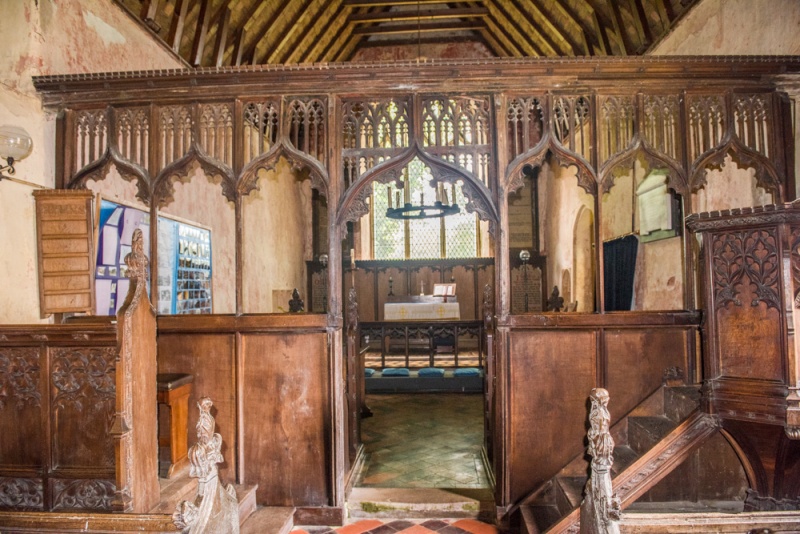
One of the 15th-century additions was a painted chancel screen, installed around 1511. Robert Elveden's will from that year notes a bequest of 6s 8d for painting and gilding the screen. The base has lost its traceried paintings, but the openwork above retains its wonderfully ornate tracery, like lace in wood. The spandrels are carved with figures of flowers and foliage and you can still make out traces of medieval painting.
Around the same period a piscina was installed, and benches with beautifully carved bench ends.
It was not easy being the vicar of Horsey parish before the fens were drained. A clue to what the area used to look like comes from the name Horsey, which translates from Old English as 'Horse Island'. The 'island' in this case was a slightly raised area of land surrounded by marshy fenland. Until the early 18th century this was a desolate area, and a dangerous place to travel.
In 1784 the curate of Horsey reported to his superiors that he had narrowly escaped drowning on three occasions when travelling to All Saints to conduct Sunday services. At that time the village had only eight households. With such a small parish it comes as no surprise to read that the church was in very poor condition, and that just four years later in 1788 two church bells were sold to raise funds to repair the church building.
The church was restored in the 1850s and 1860s by John Cory, brother of the church vicar. Cory did not just perform the restoration, he even donated the altar rails. He installed new benches in the nave, but reused original 15th-century bench ends. The beautifully carved wine-glass pulpit dates to 1856.
About Horsey, All Saints Church
Address: All Saints Lane,
Horsey,
Norfolk,
England, NR29 4EF
Attraction Type: Historic Church
Location: Just off The Street (the coast road). Signposted from the sharp bend in the middle of Horsey village.
Website: Horsey, All Saints Church
Location
map
OS: TG457230
Photo Credit: David Ross and Britain Express
HERITAGE
 We've 'tagged' this attraction information to help you find related historic attractions and learn more about major time periods mentioned.
We've 'tagged' this attraction information to help you find related historic attractions and learn more about major time periods mentioned.
Find other attractions tagged with:
NEARBY HISTORIC ATTRACTIONS
Heritage Rated from 1- 5 (low to exceptional) on historic interest
Horsey Windpump - 0.1 miles (Historic Building) ![]()
Hickling, St Mary's Church - 2.8 miles (Historic Church) ![]()
Sutton, St Michael's Church - 4.3 miles (Historic Church) ![]()
Repps, St Peter's Church - 4.4 miles (Historic Church) ![]()
Ingham, Holy Trinity Church - 4.6 miles (Historic Church) ![]()
Catfield, All Saints Church - 4.8 miles (Historic Church) ![]()
Ludham, St Catherine's Church - 5.2 miles (Historic Church) ![]()
Stalham, St Mary's Church - 5.4 miles (Historic Church) ![]()
Nearest Holiday Cottages to Horsey, All Saints Church:
More self catering near Horsey, All Saints Church
